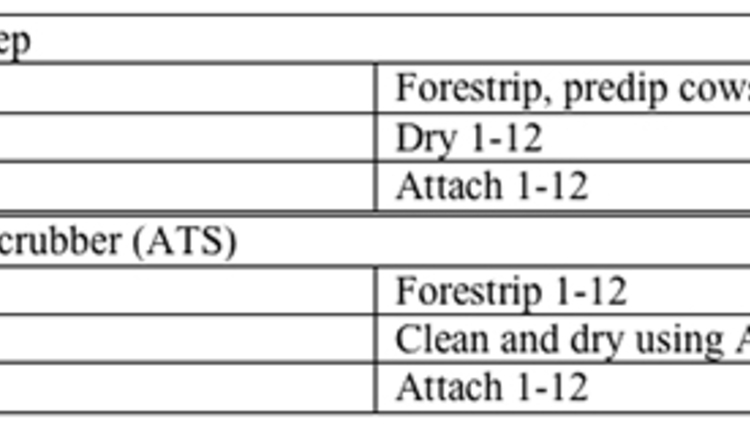Forestripping serves two purposes in the parlor: to stimulate milk letdown and aid in the detection of mild cases of mastitis. As farms adopt automated teat scrubbers to remove human variation in the milking routine, this step may be modified or eliminated. Pam Ruegg and other researchers from the University of Wisconsin-Madison evaluated how the use of teat scrubbers affects milk letdown compared to conventional preparation.
The study was conducted on a 1,200-cow dairy in Wisconsin. Two teat scrubbers were in the parlor; the farm had been utilizing the scrubbers on and off for six years. Cows averaged 90 pounds per day and were milked 3x in a double-24 parlor. Milk yield, average milk flow, peak milk flow and duration of milking were evaluated.
"The dairy's milkers were highly trained and experienced in both conventional prep and use of the teat scrubber system," noted Ruegg at the Wisconsin Dairy Field Representatives Conference. At the study's conclusion, data from 301 late-lactation cows (180 first-lactation cows and 121 older herdmates) was analyzed.
"Late lactation was selected because stimulation is more important for this group to achieve adequate milk letdown. We also wanted the data skewed toward younger cows for the same reason," added Ruegg.
Researchers visited the dairy for three subsequent afternoon milkings. The same two milking technicians performed treatments, and forestripping was used in both routines (shown below).

The prep-lag time was 113 seconds for the conventionally prepped cows and 91 seconds for those prepped with the teat scrubber.
Milk yield was significantly associated with lactation and the day of the experiment. Cows in their first lactation produced more than older cows, and milk yield on Day 2 of the study was about 1.5 pounds greater than on Day 1.
"There was no association between the order of preparation (conventional then teat scrubber, or vice versa) and yield," noted Ruegg. "On both days, though, there was a slightly greater yield for conventional prep (25.7 pounds) compared to the teat scrubber (25.3 pounds).
Cows prepped conventionally had about 6 more seconds of attachment time as compared to ATS. Peak milk flow, meanwhile, was slightly greater for cows prepped using ATS, but this effect is unlikely to be biologically significant. Milking duration was not associated with day or order, and there was no effect of teat prep on milk flow rates.
"If you have good prep and good milkers, the system should make little to no difference in production," concluded Ruegg.
Researchers also studied the bactericidal effectiveness of the scrubber's chlorine dioxide disinfectant. Read more about what they uncovered here.

The author , Amanda Smith, was an associate editor and is an animal science graduate of Cornell University. Smith covers feeding, milk quality and heads up the World Dairy Expo Supplement. She grew up on a Medina, N.Y., dairy, and interned at a 1,700-cow western New York dairy, a large New York calf and heifer farm, and studied in New Zealand for one semester.
The study was conducted on a 1,200-cow dairy in Wisconsin. Two teat scrubbers were in the parlor; the farm had been utilizing the scrubbers on and off for six years. Cows averaged 90 pounds per day and were milked 3x in a double-24 parlor. Milk yield, average milk flow, peak milk flow and duration of milking were evaluated.
"The dairy's milkers were highly trained and experienced in both conventional prep and use of the teat scrubber system," noted Ruegg at the Wisconsin Dairy Field Representatives Conference. At the study's conclusion, data from 301 late-lactation cows (180 first-lactation cows and 121 older herdmates) was analyzed.
"Late lactation was selected because stimulation is more important for this group to achieve adequate milk letdown. We also wanted the data skewed toward younger cows for the same reason," added Ruegg.
Researchers visited the dairy for three subsequent afternoon milkings. The same two milking technicians performed treatments, and forestripping was used in both routines (shown below).

The prep-lag time was 113 seconds for the conventionally prepped cows and 91 seconds for those prepped with the teat scrubber.
Milk yield was significantly associated with lactation and the day of the experiment. Cows in their first lactation produced more than older cows, and milk yield on Day 2 of the study was about 1.5 pounds greater than on Day 1.
"There was no association between the order of preparation (conventional then teat scrubber, or vice versa) and yield," noted Ruegg. "On both days, though, there was a slightly greater yield for conventional prep (25.7 pounds) compared to the teat scrubber (25.3 pounds).
Cows prepped conventionally had about 6 more seconds of attachment time as compared to ATS. Peak milk flow, meanwhile, was slightly greater for cows prepped using ATS, but this effect is unlikely to be biologically significant. Milking duration was not associated with day or order, and there was no effect of teat prep on milk flow rates.
"If you have good prep and good milkers, the system should make little to no difference in production," concluded Ruegg.
Researchers also studied the bactericidal effectiveness of the scrubber's chlorine dioxide disinfectant. Read more about what they uncovered here.

The author , Amanda Smith, was an associate editor and is an animal science graduate of Cornell University. Smith covers feeding, milk quality and heads up the World Dairy Expo Supplement. She grew up on a Medina, N.Y., dairy, and interned at a 1,700-cow western New York dairy, a large New York calf and heifer farm, and studied in New Zealand for one semester.








